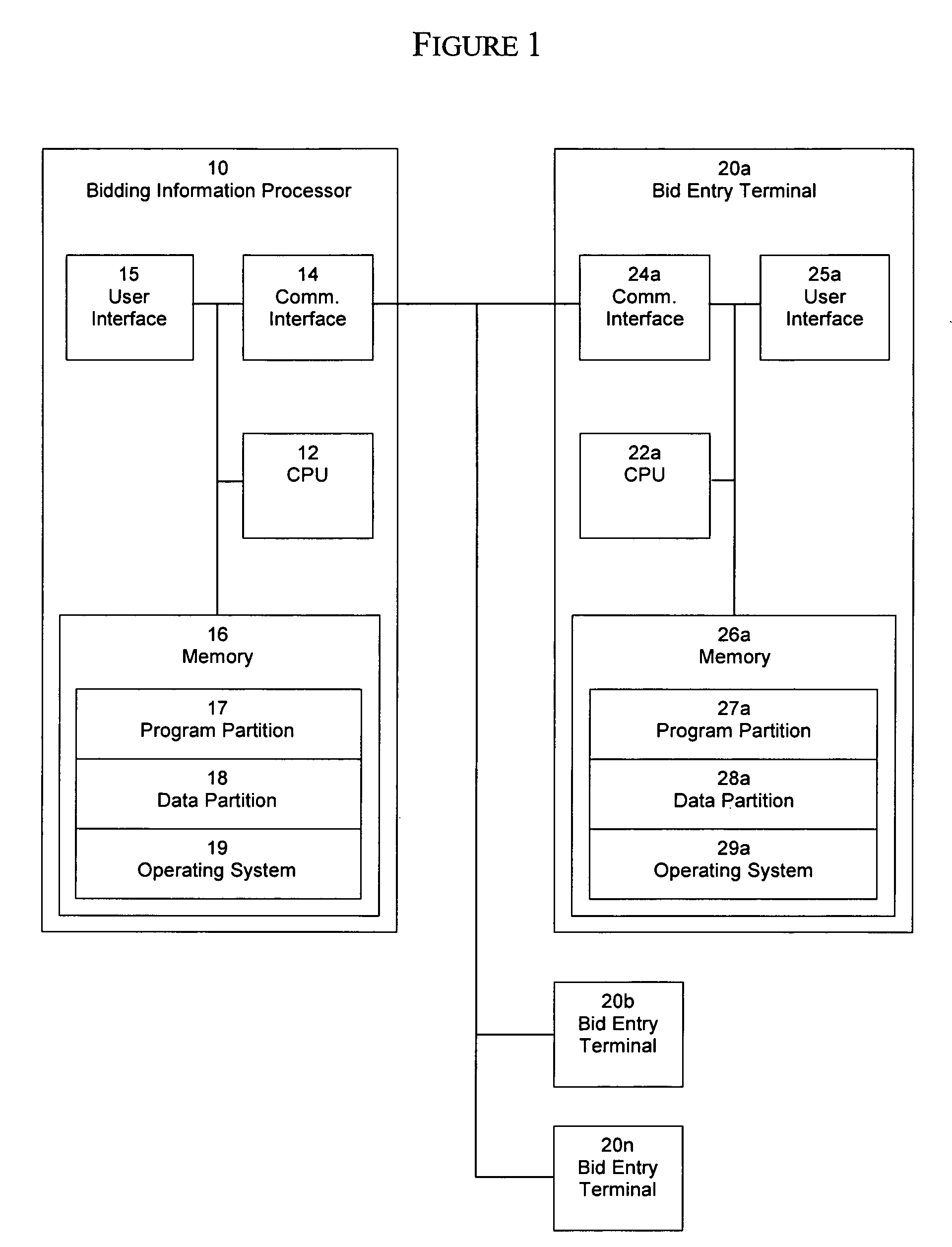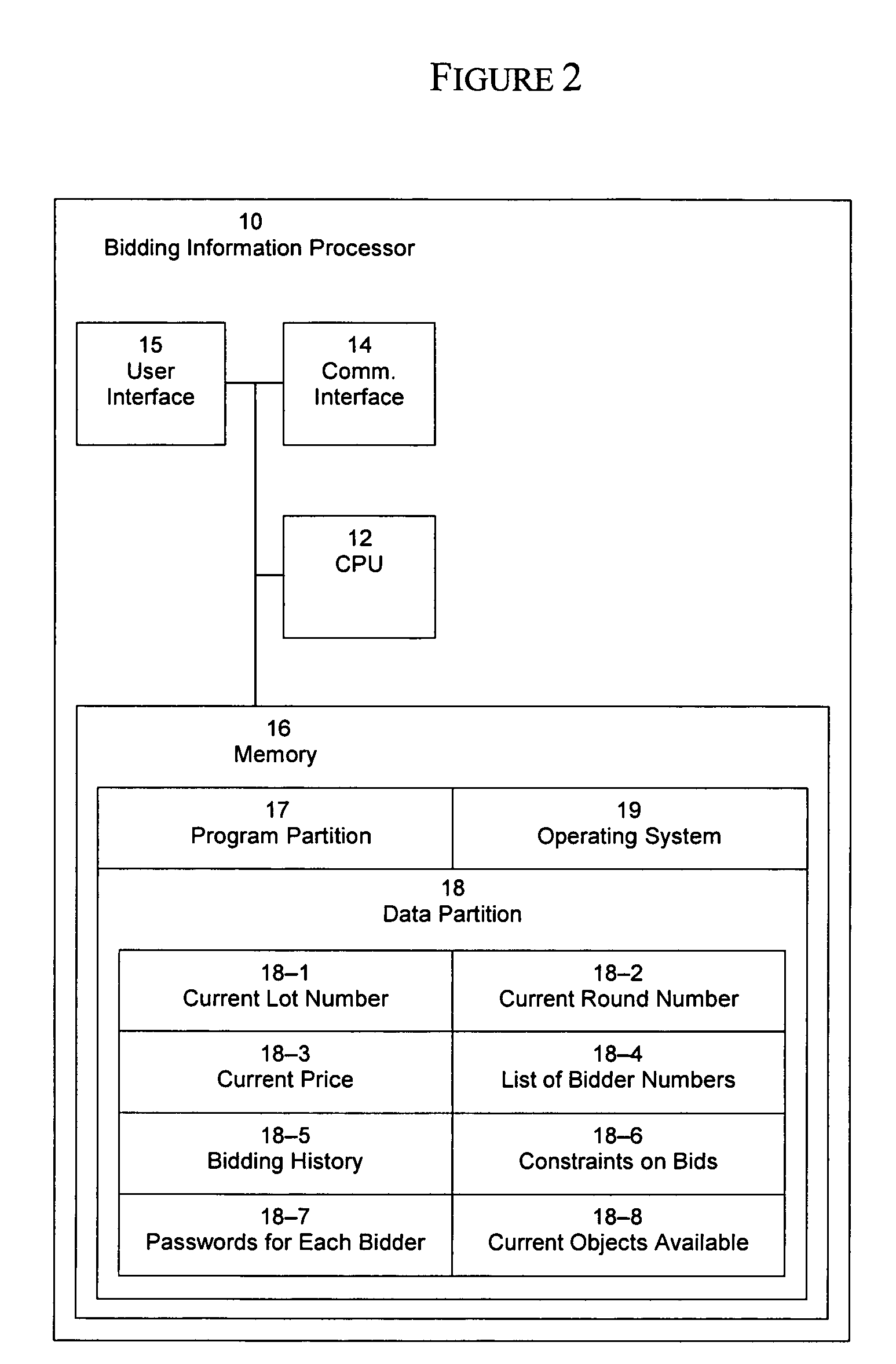System and method for an efficient dynamic multi-unit auction
a dynamic multi-unit, auction technology, applied in the field of improving computerimplemented auctions, can solve the problems of clear negative effects on efficiency and revenues, and achieve the effects of improving the economic efficiency of the auction design, ensuring the confidentiality of high values, and efficiently auctioning multiple types of goods
- Summary
- Abstract
- Description
- Claims
- Application Information
AI Technical Summary
Benefits of technology
Problems solved by technology
Method used
Image
Examples
example 1
[0055]The requirements matrix for units of each of the two types is given by Table 3. The auction is conducted as a procurement auction, and four bidders (superscripted by i=1,2,3,4) participate. At every price p, each bidder i indicates a pair (Q1i, Q2i), which gives the number of units of Type 1 and the number of units of Type 2, respectively, that he is willing to sell at price p. Suppose that, for a given price p, the following Table 4A shows the quantities that the bidders have indicated:
[0056]
TABLE 4AQ1iQ2iBidder 120Bidder 210Bidder 301Bidder 410
To begin, observe that the auction has not yet concluded, and that the auctioneer may continue by naming a new, lower price. The reason for this observation is that the party on whose behalf the auction is being conducted only wishes to purchase either 3 units of Type 1 and 1 unit of Type 2, or 4 units of Type 1 (see Table 3), whereas Bidders 1-4 are in aggregate offering 4 units of Type 1 and 1 unit of Type 2 (i.e., strictly more than...
example 2
[0061]The requirements matrix for units of each of the two types is again given by Table 3. The auction is conducted as a procurement auction, and four bidders (superscripted by i=1,2,3,4) participate. At every price p, each bidder i indicates a pair (Q1i, Q2i), which gives the number of units of Type 1 and the number of units of Type 2, respectively, that he is willing to sell at price p. Suppose that, for a given price p, the following Table 4B shows the quantities that the bidders have indicated:
[0062]
TABLE 4BQ1iQ2iBidder 111Bidder 210Bidder 301Bidder 410
To begin, observe that the auction has not yet concluded, and that the auctioneer may continue by naming a new, lower price. The reason for this observation is that the party on whose behalf the auction is being conducted only wishes to purchase either 3 units of Type 1 and 1 unit of Type 2, or 4 units of Type 1 (see Table 3), whereas Bidders 1-4 are in aggregate offering 3 units of Type 1 and 2 units of Type 2 (i.e., strictly mo...
example 3
[0067]Let the requirements matrix for units of each of three types now be given by Table 2. The auction is conducted as a selling auction, and four bidders (superscripted by i=1,2,3,4) participate. At every price vector (p1,p2,p3), each bidder i indicates a vector (Q1i, Q2i, Q3i), which gives the number of units of Type 1 that he is willing to purchase at price p1, the number of units of Type 2 that he is willing to purchase at price p2, and the number of units of Type 3 that he is willing to purchase at price p3. Suppose that, for a given price vector (p1, p2, p3), the following Table 5 shows the quantities that the bidders have indicated:
[0068]
TABLE 5Q1iQ2iQ3iBidder 110000500Bidder 25001000100Bidder 35001000200Bidder 45000600
We might also suppose that, as the auction continues, each bidder is only allowed to bid the same quantity or lower on each type of item.
[0069]To begin, observe that the auction has not yet concluded on Type 1 and Type 3, and that the auctioneer may continue b...
PUM
 Login to View More
Login to View More Abstract
Description
Claims
Application Information
 Login to View More
Login to View More - R&D
- Intellectual Property
- Life Sciences
- Materials
- Tech Scout
- Unparalleled Data Quality
- Higher Quality Content
- 60% Fewer Hallucinations
Browse by: Latest US Patents, China's latest patents, Technical Efficacy Thesaurus, Application Domain, Technology Topic, Popular Technical Reports.
© 2025 PatSnap. All rights reserved.Legal|Privacy policy|Modern Slavery Act Transparency Statement|Sitemap|About US| Contact US: help@patsnap.com



